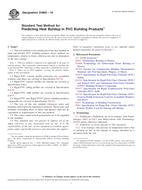We need your consent to use the individual data so that you can see information about your interests, among other things. Click "OK" to give your consent.
ASTM D4803-10
Standard Test Method for Predicting Heat Buildup in PVC Building Products
STANDARD published on 1.11.2010
The information about the standard:
Designation standards: ASTM D4803-10
Note: WITHDRAWN
Publication date standards: 1.11.2010
SKU: NS-28637
The number of pages: 5
Approximate weight : 15 g (0.03 lbs)
Country: American technical standard
Category: Technical standards ASTM
The category - similar standards:
Rubber and plastics products in generalOther rubber and plastics products
Annotation of standard text ASTM D4803-10 :
Keywords:
heat buildup, PVC building products, sun energy absorption, weathering,Temperature tests--plastics, Absorption--plastics, Ambient air/atmospheric analysis, Black light inspection, Building constructions/materials--plastics, Carbon black pigment, Color--plastics, Emittance, Energy absorption, Heating tests--building products, Heating tests--plastics, Poly(vinyl chloride)(PVC), Reflectance and reflectivity, Sunlight/monochromatic light exposure
Additional information
| Significance and Use | ||||||||||||||||||
|
Heat buildup in PVC exterior building products due to absorption of the energy from the sun may lead to distortion problems. Heat buildup is affected by the color, emittance, absorptance, and reflectance of a product. Generally, the darker the color of the product, the more energy is absorbed and the greater is the heat buildup. However, even with the same apparent color, the heat buildup may vary due to the specific pigment system involved. The greatest heat buildup generally occurs in the color black containing carbon black pigment. The black control sample used in this test method contains 2.5 parts of furnace black per 100 parts of PVC suspension resin. The maximum temperature rise above ambient temperature for this black is 90°F (50°C) for a 45° or horizontal surface when the sun is perpendicular to the surface and 74°F (41°C) for a vertical surface assuming that the measurements were done on a cloudless day with no wind and heavy insulation on the back of the specimen. See Appendix X1. This test method allows the measurement of the temperature rise under a specific type heat lamp, relative to that of a black reference surface, thus predicting the heat buildup due to the sun's energy. The test method allows prediction of heat buildup of various colors or pigment systems, or both. This test method gives a relative heat buildup compared to black under certain defined severe conditions but does not predict actual application temperatures of the product. These will also depend on air temperature, incident angle of the sun, clouds, wind velocity, insulation, installation behind glass, etc. |
||||||||||||||||||
| 1. Scope | ||||||||||||||||||
|
1.1 This test method covers prediction of the heat buildup in rigid and flexible PVC building products above ambient air temperature, relative to black, which occurs due to absorption of the sun's energy. Note 1—This test method is expected to be applicable to all types of colored plastics. The responsible subcommittee intends to broaden the scope beyond PVC when data on other materials is submitted for review. Note 2—There are no ISO standards covering the primary subject matter of this test method. 1.2 Rigid PVC exterior profile extrusions for assembled windows and doors are covered in Specification D4726. 1.3 Rigid PVC exterior profiles for fencing are covered in Specification F964. 1.4 Rigid PVC siding profiles are covered in Specification D3679. 1.5 Rigid PVC soffit profiles are covered in Specification D4477. 1.6 Rigid PVC and Rigid CPVC plastic building products compounds are covered in Specification D4216. 1.7 The text of this test method references notes and footnotes which provide explanatory material. These notes and footnotes (excluding those in tables and figures) shall not be considered as requirements of this test method. 1.8 The values stated in inch-pound units are to be regarded as the standard. 1.9 This standard does not purport to address all of the safety concerns, if any, associated with its use. It is the responsibility of the user of this standard to establish appropriate safety and health practices and determine the applicability of regulatory limitations prior to use. Specific safety hazard statements are given in Section 7. |
||||||||||||||||||
| 2. Referenced Documents | ||||||||||||||||||
|
We recommend:
Updating of laws
Do you want to be sure about the validity of used regulations?
We offer you a solution so that you could use valid and updated legislative regulations.
Would you like to get more information? Look at this page.




 Cookies
Cookies
